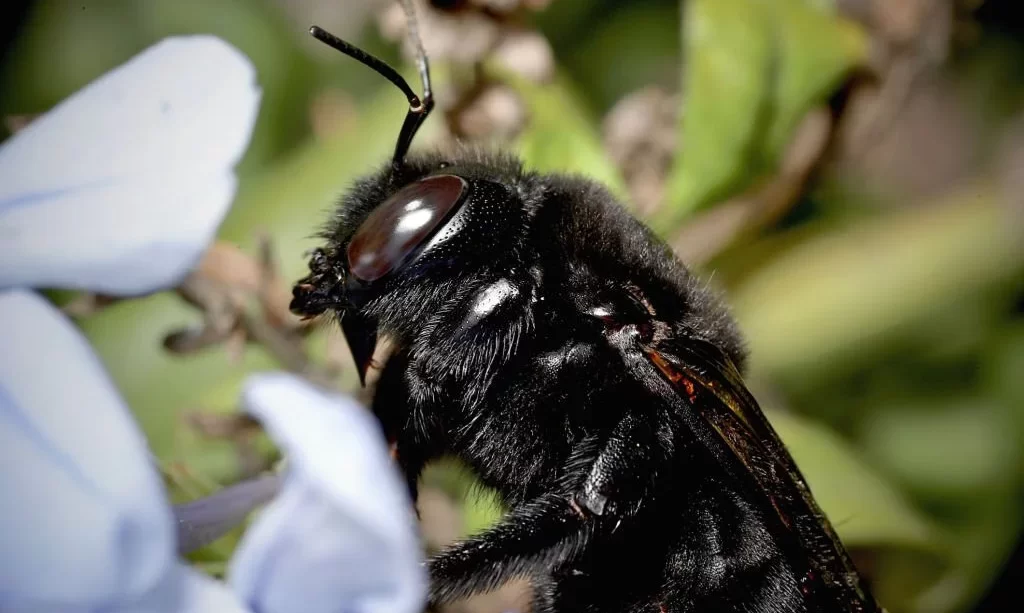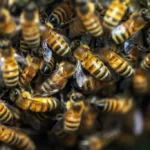Black bees, commonly referred to as carpenter bees, have a significant presence in the world of insects. They often evoke curiosity and concern due to their color and the general fear associated with bee stings. In this article, we will explore whether black bees, particularly carpenter bees, are dangerous to humans. By understanding their behavior, stinging tendencies, and the factors that influence their interactions with people, we can demystify these insects and shed light on their true nature.
Black Bees
Black bees encompass a diverse group of bee species, with carpenter bees being one of the most recognizable types. To gain a comprehensive perspective, it’s essential to understand their characteristics and behavior:
- Physical Appearance: Carpenter bees, known for their black or dark brown coloration, can be easily distinguished by their robust and often shiny bodies. They have a resemblance to bumblebees but lack the characteristic yellow markings.
- Nesting Habits: Carpenter bees are solitary bees that construct their nests in various wooden structures, such as trees, wooden fences, and even homes. They create tunnel-like galleries inside the wood to lay their eggs and provide for their offspring.
- Diet: Like most bees, carpenter bees primarily feed on nectar and pollen, making them valuable pollinators for many plants and flowers.
Bee Stings: The Concern
One of the primary reasons for the concern surrounding black bees, or any bee for that matter, is the fear of bee stings. Bee stings can indeed be painful and, for some individuals, trigger allergic reactions. Here’s what you need to know:
- Stinging Mechanism: Bees, including carpenter bees, possess a stinger as a means of defense. When threatened or provoked, they may use their stinger to deliver venom, resulting in a bee sting.
- Allergic Reactions: While most people experience mild to moderate pain, redness, and swelling at the site of a bee sting, some individuals may be allergic to bee venom. An allergic reaction can lead to more severe symptoms, including difficulty breathing and anaphylaxis, a potentially life-threatening condition.
- Carpenter Bee Behavior: Unlike some other bee species, carpenter bees, particularly the males, are less likely to sting humans. They are known for their relatively mild temperament and are often more interested in defending their nesting sites than in stinging people.
In the following sections, we will delve deeper into whether black bees, specifically carpenter bees, should be considered dangerous to humans and under what circumstances they may pose a threat.
Are Black Bees Dangerous?
The question of whether black bees, such as carpenter bees, are dangerous to humans requires a nuanced answer. In general, black bees, including carpenter bees, are not considered dangerous insects. Here’s why:
- Non-Aggressive Behavior: Male carpenter bees, which are often the ones encountered by humans, are largely non-aggressive. They are known for their territorial behavior, defending their nesting sites, but they seldom exhibit aggressive tendencies towards people.
- Limited Stinging Incidents: Carpenter bees, including females, do possess stingers. However, they typically reserve stinging for self-defense when they perceive a direct threat. Even in such cases, they are less likely to sting compared to other bee species like honeybees or wasps.
- Mild Stings: In the rare instances when carpenter bees do sting, the pain and discomfort are usually mild to moderate, similar to a typical bee sting. Allergic reactions are relatively uncommon.
The Exception: Female Carpenter Bees
While male carpenter bees are generally harmless to humans, the exception lies with the female carpenter bees. Female carpenter bees can indeed sting if they feel cornered or provoked. This is more likely to occur when humans attempt to handle them or disturb their nests.
Managing Carpenter Bees
For those concerned about potential interactions with carpenter bees or who want to protect wooden structures from nesting damage, there are several non-lethal and eco-friendly methods for managing these insects:
- Protective Clothing: If you need to be in close proximity to carpenter bees, wearing protective clothing can minimize the risk of stings.
- Nest Prevention: Seal or treat exposed wood surfaces to deter carpenter bees from nesting. Paints, stains, or natural repellents can be effective.
- Carpenter Bee Traps: Commercial or DIY carpenter bee traps can help reduce their presence around your property without harming them.
- Observation and Respect: Simply observing carpenter bees from a safe distance and respecting their space can often lead to peaceful coexistence.
- Eliminate Wasps – Our exclusive VisiLure technology lures wasps, red wasps, mud daubers, and carpenter bees with appealing colors and a multi-dimensional pattern. Once attracted, they become stuck to the sticky surface and expire.
- Visual Attractant – The targeted insects are naturally lured to the trap without odors, chemicals, or wasp sprays. It catches queens and workers, from spring through fall.
- Thoughtful Design – Our unique Glue Guards create a barrier around the sticky trap surface to reduce the chances of non-insect catches.
- Prevent Damage – Mud daubers (mud wasps, dirt daubers) and carpenter bees can cause serious property damage. Our TrapStik can stop this before it starts, without the use of potentially harmful sprays or chemicals.
- Made in the USA – At RESCUE!, our goal is to design, manufacture, and market the safest and most effective pest control solutions available for homeowners. We are proud to manufacture our products in the USA!
Conclusion
In conclusion, black bees, including carpenter bees, are not inherently dangerous to humans. They play valuable roles as pollinators and are generally non-aggressive, with male carpenter bees being particularly mild-mannered. However, it’s essential to exercise caution around female carpenter bees, as they can sting if they perceive a threat.
Managing carpenter bees can be achieved through non-lethal methods that prioritize their well-being and your peace of mind. By understanding these fascinating insects and taking appropriate precautions, you can share your outdoor space with carpenter bees while minimizing any potential risks.





